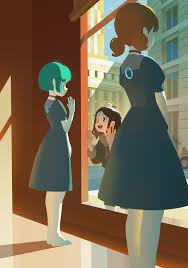Okay, so I just finished Klara and the Sun and I’m still kind of freaking out. Like, this book is SO good, but also SO weird. It’s like Ishiguro took a left turn into the Twilight Zone and wrote a story about an AI who wants to be a best friend.
Klara, our AF narrator, is the sweetest thing ever. She’s like a big-eyed puppy who’s trying really hard to understand humans. Klara's whole thing about the Cootings Machine blocking the sun is a total metaphor for pollution and how it's messing up our world. An Artificial Friend (AF) is a type of robot that is sold to act as something like a nanny to children. There are different models of AFs, with B3s being more advanced than B2s (like Klara). AFs are also gendered, with some being referred to as Girl AFs and others as Boy AFs.
Josie, the girl she’s obsessed with, is this fragile little flower who’s clearly got some serious issues going on. I mean, the whole genetic modification thing is a whole other can of worms, but let’s not even go there yet. Then there's Josie, this sick kid who everyone's hoping Klara can save. It’s heartbreaking, but it also makes you think about how far we're willing to go to fix people, you know?
This whole "lifting" thing is super creepy, like playing God or something.Lifting may have been inspired by a real-life process called CRISPR gene editing, which raises ethical questions about the possibility of modifying human embryos.
The sun, obviously, is a major player. It's like this all-seeing, all-powerful entity that everyone depends on. But is it really just a giant ball of fire, or is it something more? Ishiguro leaves you hanging there, and I love it.Klara and the Sun isn't just about a sweet AI and a sick kid. It's a whole lot deeper than that. Let's talk about the sun, because, like, duh, it's the whole point.
Klara calls the sun "our primeval parent." Can you even imagine thinking about the sun like that? It's wild. Ishiguro is basically saying the sun is the source of all life, which is pretty deep. But it’s also about knowledge and understanding. Remember when Klara says, "I am learning to see what things mean"? She's like a little sponge soaking up everything, just like we do from the sun.
Then there’s Josie. Poor kid. She's this symbol of human fragility and the limits of science. And let's not forget her mom's painter friend. That whole communist vibe is super interesting. It's like Ishiguro is saying that even amidst all this technological advancement, there's still this longing for a simpler, more equal world.
But the craziest part? Klara becoming a kind of new Josie. It's like she's filling this void, this empty space. It's super messed up, but also kind of beautiful. Like, maybe there's hope for humanity after all, even if it's through an AI.
“Well, Klara. Since you appear to know so much about it. Will you please reproduce for me Josie’s walk? Will you do that for me? Right now? My daughter’s walk?”
I know this is all over the place, but that’s kind of how this book made me feel. It’s like a rollercoaster of emotions and questions. I'm still trying to wrap my head around everything.Klara taking down the Cootings Machine? That's some serious robot rebellion! But it's also about standing up for what's right, even if it's a long shot.
“Klara deserves better. She deserves her slow fade.”
Have you read Klara and the Sun?
Thank You




